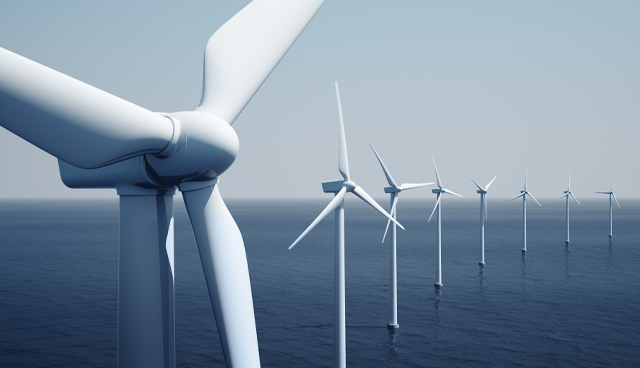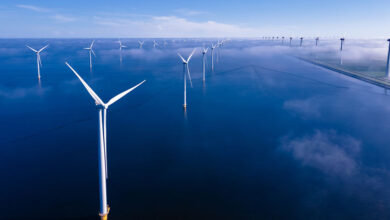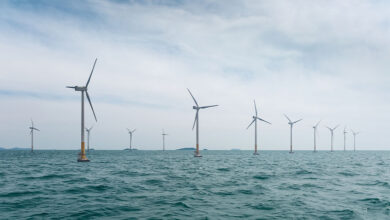Offshore wind: An international perspective

In setting out a target of 5GW of offshore development by 2030, Ireland has outlined an ambition to be a world leader in renewable energy and has the opportunity to learn lessons from the offshore pacesetters.
Ireland’s onshore wind development has moved at pace and is central to progress of renewables on to the electricity system. Onshore wind will continue to be the major player in terms of renewable generation up to and beyond 2050 but if Ireland is to reach a target of net zero carbon by 2050, it is recognised that significant development of offshore wind and other emerging technologies will be required.
The Programme for Government raised the ambition for offshore development from 3.5GW to 5GW for 2030 on Ireland’s eastern and southern coasts and set a vision for a potential 30GW on the western coast out to 2050.
Industry leaders have stressed the importance of Ireland meeting the Climate Action Plan target of 1GW to be delivered by 2025 if the 2030 target is to be reached and pointed to the need to prioritise trigger projects in the planned offshore-dedicated RESS auction in 2021.
The Irish Government has embraced a phased approach to offshore development, seeing the value in targeting nearshore and shallow water offshore deployment on the east coast for fast deployment. The south coast, where the water gets deeper quickly, will form a second phase, with a wider range of technology required, including fixed beds and floating. The greatest challenge will be Ireland’s west coast, where a range of limitations, not least grid absence, wave height and access limitations will require a reliance on technology innovation and emergence in the coming decades.
While Ireland aims to be a global leader in renewable energy and harness the potential of renewable electricity exportation, it is not an early pacesetter in the deployment of offshore wind technology. The Government will seek to learn from the pathways taken by other countries, not least the UK, but must also recognise an increase in competition in the offshore global market, where skills, investment, vessels and turbine availability will become squeezed.
A global leader in offshore wind, the UK will serve as an exemplar to Ireland’s deployment. The UK currently has the largest installed capacity of offshore wind in the world, with over 10GW in operation off its coasts, however, it took some 15 years to get from initial deployment to get to its first 5GW. Generation from offshore wind made up around 10 per cent of UK electricity in 2020, equivalent to powering 4.5 million homes and now represents one of the lowest cost options for new power in the UK, with prices falling by 50 per cent since 2015.
The UK Government has recently increased its own 2030 targets from 30GW to 40GW, with the ambition to produce enough electricity from offshore wind to power every home and to make offshore the country’s biggest energy source. The Build Back Greener initiative includes a new target to deliver 1GW of floating offshore wind by 2030.
China has the fastest growing offshore wind sector, globally. A Global Wind Energy Council report estimates that China accounted for 40 per cent of the globally added offshore capacity in 2019 and now has around 23 per cent of the world’s offshore wind capacity. China intends to add a further 52GW of offshore wind capacity by 2030 to its existing 5.9GW generation. Currently China holds 94 per cent of Asia’s total offshore wind capacity.
China has over 18,000km of coastline and current resources are concentrated on the south-east coast and China’s islands. Its economic activity is concentrated on its coasts. However, China’s electricity from renewable sources is still dominated by onshore wind, most of which is located in the north of the country and requires transportation. Land scarcity and grid connection challenges have driven the push towards offshore.
The German Government, in line with enhanced European Commission aspirations, has outlined plans to reach 40GW of offshore wind power capacity by 2040. Currently, Germany generates around 7.5GW of electricity from offshore wind but has outlined a 20GW target for 2030 as a stepping stone to its 2040 ambitions.
Germany constructed its first commercial offshore wind farm in 2009 in the Baltic Sea and currently boasts over 20 offshore wind farms between it and the North Sea. However, a slowdown in Germany’s offshore expansion has been recorded with 1,400 new offshore wind turbines added in 2020 compared to 1,800 in 2017. In response the German Bundestag passed an amendment to the Wind Energy at Sea Act (WindSeeG) in late 2020 to provide for an expansion of offshore in the coming years, not least a target of average annual generation and grid capacity increases of 2GW from 2030 to 2040. Interestingly, the increase in offshore wind generation capacity is envisaged through cooperation with other EU member states bordering the North and Baltic seas, including the potential of opening auctions for wind farms located in territorial waters.
Belgium now ranks fourth behind the UK, Germany and China in terms of installed offshore wind capacity. The completion of the 497MW SeaMade project, the largest windfarm in the Belgian North Sea, saw Belgium reach an installed capacity of 2.3GW. Despite a smaller population size than its counterparts of other leading offshore wind countries and relatively limited marine territory, Belgium’s current installed capacity represents around 10 per cent of total electricity consumption in the country. Having first began offshore development in 2009, a delay was recognised in 2015 and 2016 due to social acceptance challenges with a land-based connection but was later resolved.
After over a year of government formation talks, a coalition government was formed in late 2020 and has set out an ambition to double the country’s offshore wind capacity to 4GW to 2030.





